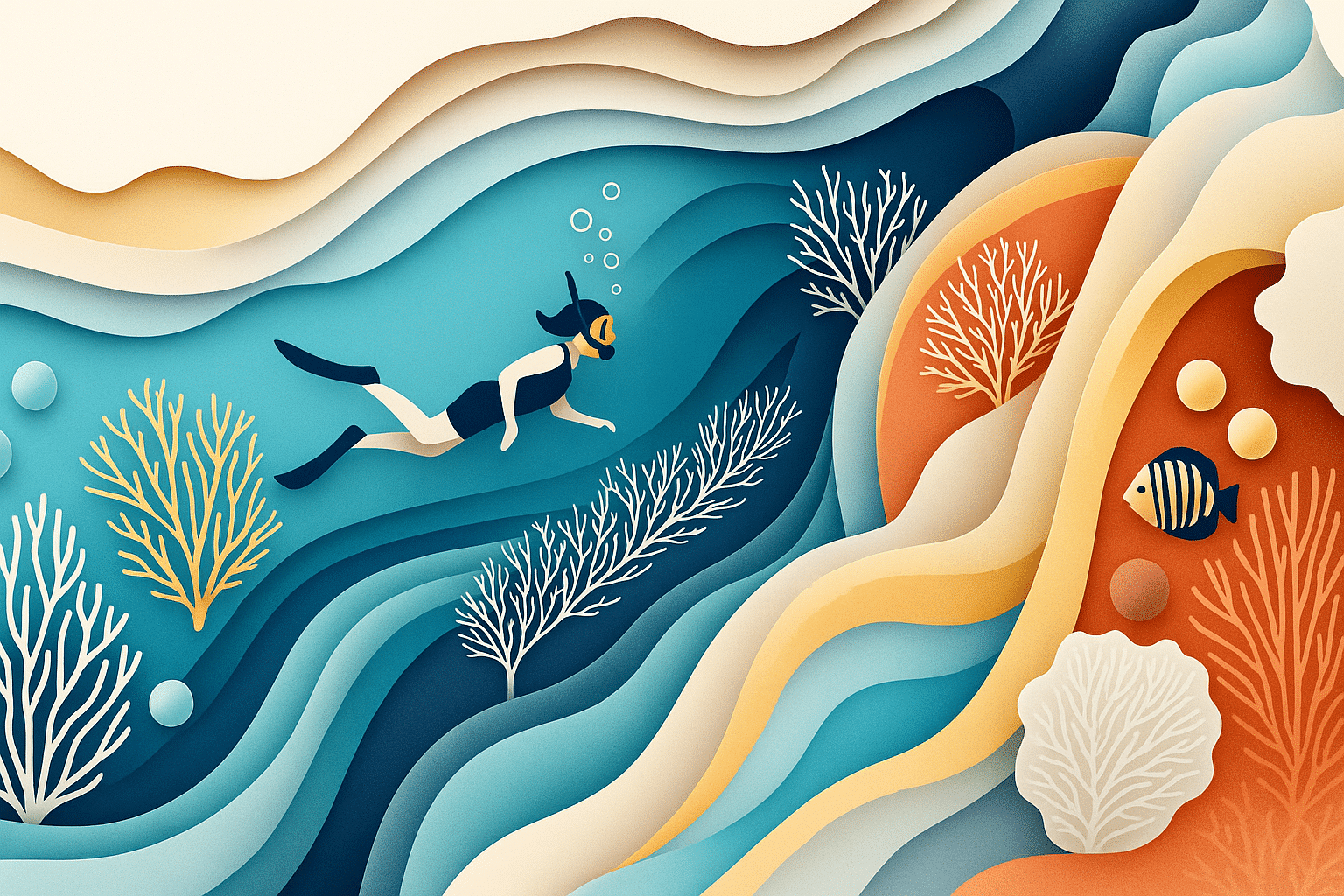What is World Snorkeling Day?
World Snorkeling Day is held every year on July 30 and is observed worldwide. The day celebrates snorkeling as an accessible and relaxing way to explore shallow waters. It requires little equipment and no formal training, which makes it open to people of many ages and backgrounds. Participants can float on the surface while watching fish, plants and coral in their natural environment. This direct encounter creates awareness and appreciation for underwater ecosystems.
The day is also a chance to slow down. Snorkeling asks for calm movements and careful observation. It is not a sport of speed but of quiet focus. Because of this, it brings together people who value nature and personal experience. Many join activities near the coast, in lakes or in protected bays. Some take part in group events, while others prefer to explore alone or with friends.
History and Origin
Snorkeling has a long and practical history. Early forms appeared in regions where people needed to gather food or observe the sea. In ancient Greece, some used reeds to breathe at the surface while hunting underwater. In island cultures across the Pacific, people became skilled in shallow diving and surface swimming. The basic idea was always the same: to stay close to the surface and watch what happens below.
In the twentieth century, materials like rubber and glass made it possible to create simple masks and snorkels. These items allowed people to see more clearly and breathe with comfort. The rise of tourism near coral reefs helped turn snorkeling into a common leisure activity. Resorts, beach clubs and travel companies began offering guided swims along the shore. This new form was recreational but also deeply personal. Many people remember their first glimpse of fish or coral as a lasting image.
World Snorkeling Day started when environmental groups and water sport instructors saw a need for public attention. They wanted a day that combined learning and fun, without barriers. The idea was to invite people into the water, not through pressure, but through curiosity. The first events were small and local. They included beach talks, short swims and informal cleanups. Over time, the idea spread to other coastal areas, where similar concerns and interests existed.
Today, the day is marked in regions far beyond the tropics. In some places, it is linked to marine education. In others, it serves as a reason to bring families outside. What unites these celebrations is the belief that nature becomes more valuable when it is seen directly.
Who participates in World Snorkeling Day?
- Recreational swimmers: People who enjoy spending time near the coast often use the day to explore local waters.
- Snorkeling instructors: Guides organize short tours or safety sessions to help newcomers start with confidence.
- Marine education groups: These organizations lead workshops or talks about reef life and safe observation.
- Families and schools: Parents and teachers introduce children to marine life through simple, guided swims.
- Environmental activists: The day is used to combine snorkeling with clean-up actions or monitoring projects.
Slogans and Themes
The themes of World Snorkeling Day focus on observation, respect and connection. Slogans like “See more than the surface” or “Float with care” reflect the spirit of the activity. Some campaigns focus on reef awareness. Others highlight safety, access or clean water. The message is always linked to personal experience. By seeing fish, plants and formations in their natural setting, people gain new insight into what is worth protecting.
Colors, Symbols and Patterns
Colors:
- Ocean blue: Reflects the wide and calm waters that attract snorkelers worldwide.
- Soft green: Represents underwater vegetation and shallow marine habitats.
- Coral orange: Reminds people of reef life and its delicate structures.
Symbols:
- Snorkel mask and fins: Clear signs of the activity, often used in promotions.
- Sea turtle or fish icon: Represents peaceful marine life often seen while snorkeling.
- Wave line: A simple, flowing shape that connects land and sea.
Patterns:
- Underwater silhouettes: Often used to show different species without detail.
- Reef maps: Stylized drawings of areas where snorkeling is common and safe.
- Bubble trails: Visual patterns that reflect movement and quiet breathing.
Most Used Hashtags
- #WorldSnorkelingDay
- #SnorkelAndSee
- #UnderwaterView
- #FloatAndDiscover
- #MarineMoments
How do you celebrate World Snorkeling Day?
- Explore a local site: Visit a calm beach, lake or lagoon and observe what lives below the surface.
- Join a group event: Many clubs and guides offer special swims or lessons for this day.
- Take a safety class: Learn how to snorkel responsibly and how to spot healthy marine environments.
- Record your experience: Use photos, sketches or short notes to reflect on what you saw.
- Support marine access: Help local groups that protect clean entry points for public snorkeling.
Why is World Snorkeling Day important?
World Snorkeling Day is important because it brings people in direct contact with the underwater world. This experience creates a deeper understanding of marine life and the environments it depends on. Floating above corals or plants allows people to observe without touching or disturbing. That way of seeing helps develop care and attention. Many people describe their first snorkeling experience as something that changed how they think about water and animals.
The day also shows how nature can be explored without pressure or performance. Snorkeling requires no speed, no competition and no noise. It invites a slower rhythm and a different kind of focus. This calm way of moving creates a lasting effect, even after the activity is done. World Snorkeling Day is not about how far you go, but how clearly you look.
Features
July 30: Snorkeling Day
Why do you keep falling for the same type?
Read the article Lovemaps: the hidden blueprint of our love.

